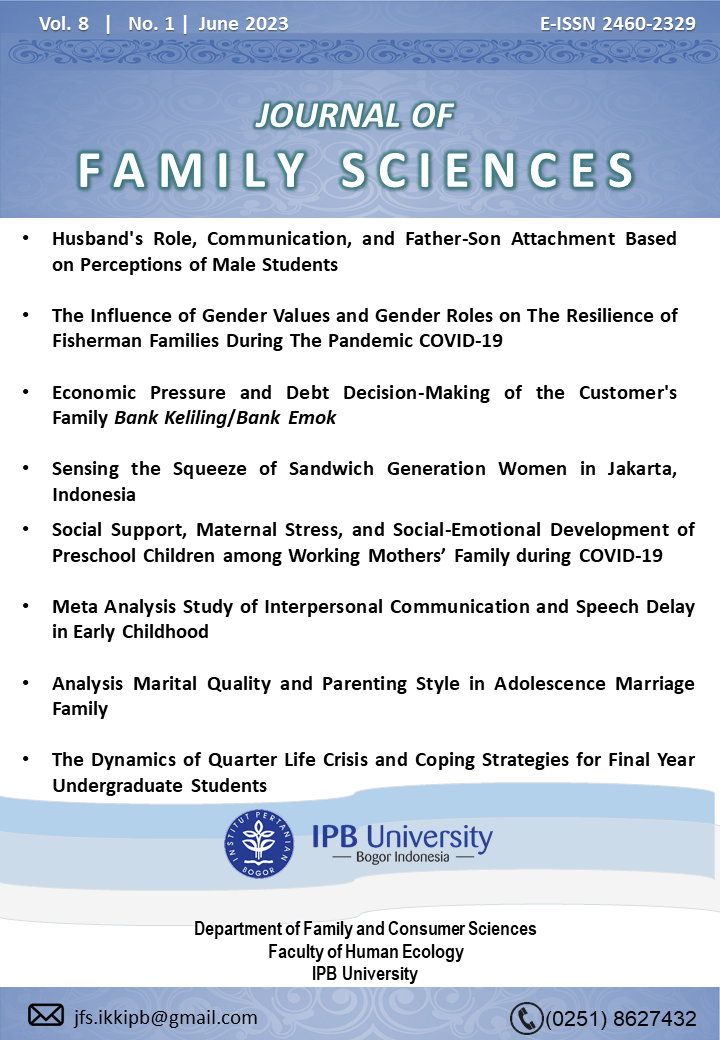Analysis Marital Quality and Parenting Style in Adolescence Marriage Family
Analysis Marital Quality and Parenting Style in Adolescence Marriage Family
Abstract
Marriage during adolescence has an impact on the unpreparedness of families to carry out family duties and functions, including in building the quality of marriage and childcare. This study aims to analyze the quality of marriage and parenting styles in families who married in adolescence. This study used a phenomenological qualitative descriptive method using a purposive sampling technique. There were 3 participants in this study with criteria of mothers who married during adolescence and had children. This research was conducted in Purwakarta Regency in February-April 2022. Data collection techniques used observation, and semi-structured interviews with data analysis, reduction, and conclusion. The results showed that the quality of marriage in families who married in adolescence had low-quality marriages as indicated by poor communication between family members and low family economic conditions. In parenting styles, families generally adopt a permissive parenting style which is shown by giving warm affection to children but not accompanied by clear and consistent rules.
Downloads
References
Adams, M. M. (1999). Marital status and happiness. Journal of Marriage and Family, 60(2), 527-536. https://doi.org/10.2307/353867
[BPS] Badan Pusat Statistik. (2018). Survey Sosial Ekonomi Nasional. Jakarta(ID): BPS.
[BPS] Badan Pusat Statistik. (2020). Proporsi perempuan umur 20-24 tahun yang berstatus kawin atau berstatus hidup bersama sebelum umur 18 tahun menurut Provinsi (persen), 2020-2022. Jakarta(ID): BPS.
[Bappenas] Badan Perencanaan dan Pembangunan Nasional. (2020). Pentingnya Kesetaraan Pemahaman untuk Pencegahan Perkawinan Anak. Jakarta(ID): Bappenas.
Bradbury, T. N., & Karney, B. R. (1993). Longitudinal study of marital interaction and dysfunction: review and analysis. Clinical Psychology Review, 13(1), 15–27. doi:10.1016/0272-7358(93)90005-7
Carstensen, L. L., Graff, J., Levenson, R. W., & Gottman, J. M. (1996). Affect in intimate relationships. The Developmental course of marriage. Handbook of emotion, adult development, and aging. (1997). Choice Reviews Online, 34(9), 34–5373. https://doi.org/10.5860/choice.34-5373
Creswell, J. W. (2008). Educational research: Planning, conducting, and evaluating quantitative and qualitative research. London(UK): Pearson
Fitrah, M., & Lutfiyah. (2017). Metodologi Penelitian: Penelitian Kualitatif, Tindakan Kelas & Studi Kasus. Sukabumi(ID): CV Jejak Publisher.
Habibi, M. A., & Muazar. (2015). Analisis Kebutuhan Anak Usia Dini. Yogyakarta(ID): Deepublish.
Hastuti, D. (2015). Pengasuhan: Teori, Prinsip, dan Aplikasinya di Indonesia. Bogor(ID): IPB Press.
Larson, J. H., Anderson, S. M., Holman, T. B., & Niemann, B. K. (1998). A longitudinal study of the effects of premarital communication, relationship stability, and self-esteem on sexual satisfaction in the first year of Marriage. Journal of Sex & Marital Therapy, 4(3), 193-206. https://doi.org/10.1080/00926239808404933
Law Number 1 of 1974 concerning Marriage. (January 2, 1974). State Institution of the Republic of Indonesia Year 1974 Number 1. Jakarta
Law (UU) concerning Amendments to Law Number 1 of 1974 concerning Marriage. (15 October 20169). State Institution of the Republic of Indonesia Year 2019 Number 16. Jakarta
Law (UU) No. 23 of 2002 concerning Child Protection. (22 October 2002). State Institute of the Republic of Indonesia Year 2002 Number 23. Jakarta
Miles, M. B., & Huberman, A. M. (1994). Qualitative Data Analysis: An Expanded Sourcebook. California(US) Sage Publication.
Puspitawati, H. (2012). Gender dan Keluarga: Konsep dan Realita di Indonesia. Bogor (ID): IPB Press.
Rizkillah, R., Sunarti, E., & Herawati, T. (2015). Kualitas perkawinan dan lingkungan pengasuhan pada keluarga dengan suami istri bekerja. Jurnal Ilmu Keluarga dan Konsumen, 8(1), 10-19. https://doi.org/10.24156/jikk.2015.8.1.10
Rokoyah, N. F., & Hastuti, D. (2019). Mother’s parenting style and television media access determining bullying behavior on elementary school children. Jurnal Ilmu Keluarga dan Konsumen, 12(1), 52–62. https://doi.org/10.24156/jikk.2019.12.1.52
Rosen-Grandon, J. R., Myers, J. E., & Hattie, J. H. (2004). The relationship between marital characteristics, marital interaction processes, and marital satisfaction. Journal of Counseling and Development, 82(1), 58–68. https://psycnet.apa.org/doi/10.1002/j.1556-6678.2004.tb00286.x
Santrock, J. W. (2012). Life span development. Ed 5; alih bahasa Juda D, Achmad C; editor, Herman Sinaga Yati Sumuharti. Jakarta(ID): Erlangga.
Sarifudin, Hastuti, D., & Simanjuntak, M. (2020). Gaya pengasuhan otoriter dan permisif serta tingkat stress ibu sebagai faktor resiko gangguan emosi dan perilaku anak usia sekolah. Jurnal Ilmu Keluarga dan Konsumen, 13(2), 163-174. https://doi.org/10.24156/jikk.2020.13.2.163
Sarker, O. N., & Rahman, M. (2012). Factors affecting early marriage and early conception of women: a case of slum areas in Rajshahi city, Bangladesh. International Journal of Sociology and Anthropology, 4(2), 54-62. http://dx.doi.org/10.5897/IJSA11.145.
Schmitt, M., Kliegel, M., & Shapiro, A. (2007). Marital interaction in middle and old age: A predictor of marital satisfaction?. The International Journal of Aging and Human Development, 65(4), 283-300. https://doi.org/10.2190/AG.65.4.a.
Seidman, I. (2006). Interviewing as qualitative research. New York(US): Teachers College.
Sunarti, E., Tati, & Atat, S. N. (2005). Pengaruh tekanan ekonomi keluarga, dukungan sosial, kualitas perkawinan, pengasuhan, dan kecerdasan emosi anak terhadap prestasi belajar anak. [Skripsi]. Departemen Ilmu Keluarga dan Konsumen, Fakultas Ekologi Manusia, IPB University. Retrieved from https://repository.ipb.ac.id/handle/123456789/52156
Tsania, N., Sunarti, E., & Krisnatuti, D. (2015). Karakteristik keluarga, kesiapan menikah istri, dan perkembangan anak usia 3-5 tahun. Jurnal Ilmu Keluarga dan Konsumen, 8(1), 28-37. https://doi.org/10.24156/jikk.2015.8.1.28
Tyas, F. P., & Herawati, T. (2017). Kualitas pernikahan dan kesejahteraan keluarga menentukan kualitas lingkungan pengasuhan anak pada pasangan yang menikah usia muda. Jurnal Ilmu Keluarga dan Konsumen, 10(1), 1-12. https://doi.org/10.24156/jikk.2017.10.1.1.
[WHO] World Health Organization. (2019). Trends in maternal mortality 2000 to 2017: estimates by WHO, UNICEF, UNFPA, World Bank Group and the United Nations Population Division: executive summary. Geneva(CH): World Health Organization. Retrieved from https://apps.who.int/iris/handle/10665/327596
UNICEF. (March, 2021). COVID-19: A threat to progress against child marriage. Retrieved from https://data.unicef.org/resources/covid-19-a-threat-to-progress-against-child-marriage/
Authors who publish with this journal agree to the following terms:
- Authors retain copyright and grant the journal right of first publication with the work simultaneously licensed under

This work is licensed under a Creative Commons Attribution 4.0 International License. that allows others to share the work with an acknowledgement of the work's authorship and initial publication in this journal. - Authors are able to enter into separate, additional contractual arrangements for the non-exclusive distribution of the journal's published version of the work (e.g., post it to an institutional repository or publish it in a book), with an acknowledgement of its initial publication in this journal.
- Authors are permitted and encouraged to post their work online (e.g., in institutional repositories or on their website) prior to and during the submission process, as it can lead to productive exchanges, as well as earlier and greater citation of published work (See The Effect of Open Access).



_001.png)



